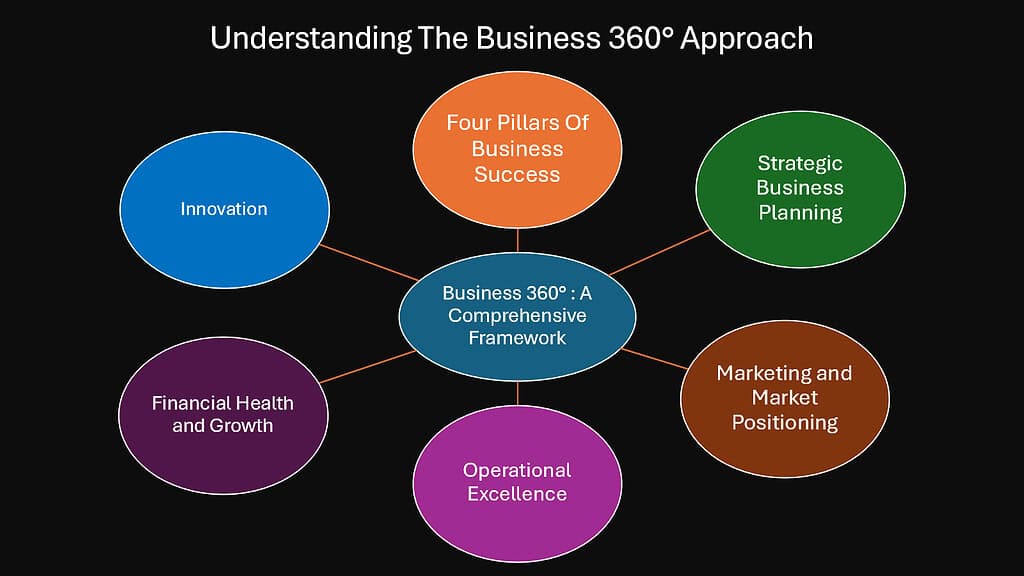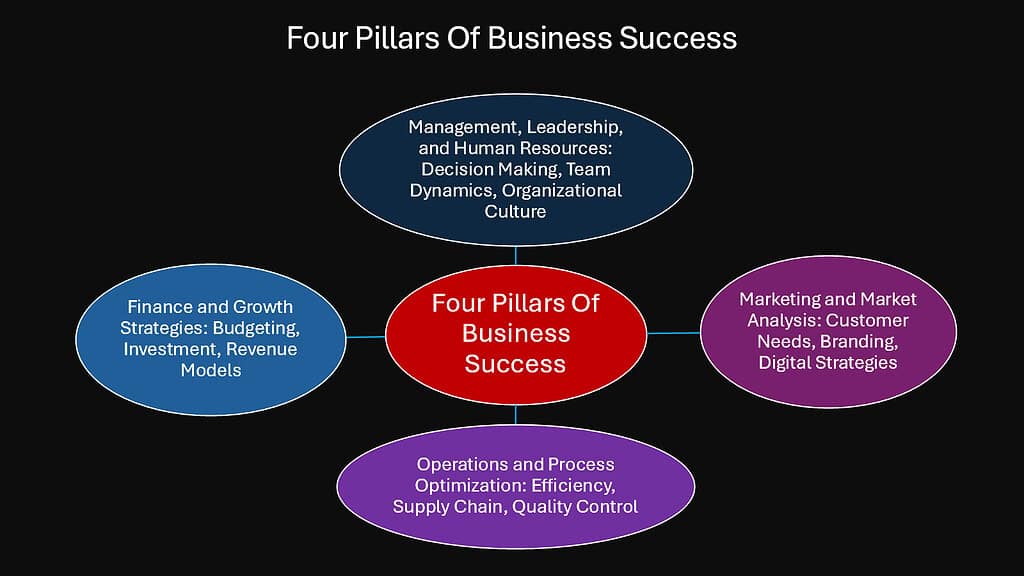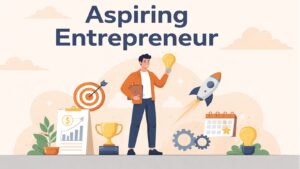Table of Contents
Introduction: A Complete Business 360° Approach

Business success no longer depends on mastering just one skill or focusing on a single department. The modern marketplace demands something more comprehensive. Welcome to the Business 360° approach, where every element of your organization works in harmony to create lasting growth.
Think of your business as a wheel. Each spoke represents a crucial component: management, human resources, marketing, operations, finance, and innovation. When one spoke weakens, the entire wheel becomes unstable. But when all spokes work together, your business rolls forward with unstoppable momentum.
The Business 360° framework recognizes that sustainable growth emerges from the intersection of strong leadership, engaged employees, smart marketing, efficient operations, solid finances, and continuous innovation. Companies that embrace this holistic view don’t just survive market changes—they thrive through them.
Research shows that businesses implementing comprehensive approaches see significantly better results than those focusing on isolated improvements. Nearly 80% of companies report there is a leadership development gap, while organizations struggle to connect their various departments into a cohesive strategy.
The following sections will guide you through each pillar of the Business 360° approach, showing how management expertise, marketing insight, operational excellence, financial discipline, and innovative thinking create a powerful synergy that transforms ordinary businesses into market leaders.
Current Business Leadership Landscape
| Leadership Challenge | Percentage | Impact on Business Growth |
|---|---|---|
| Leadership Development Gap in a Business | 80% | Reduced succession planning effectiveness |
| Employee Trust in Leaders | 69% | Lower engagement and productivity |
| Leadership Failure Rate (First 18 Months) | 40% | Increased turnover and strategic disruption |
| Companies Using Leadership Development Programs | 50% | Enhanced talent pipeline and retention |
| Leaders with Natural Leadership Talent | 10% | Need for structured development programs |
Source: TeamStage Leadership Statistics 2024, Fit Small Business 2024
1. Four Pillars of Business Success: The Core Foundations

Management, Leadership, and Human Resources
Strong leadership forms the backbone of every successful business venture. Decision making shapes not just daily operations but the entire trajectory of organizational growth. When leaders understand how to balance strategic vision with practical execution, they create environments where teams flourish.
Team dynamics directly influence productivity, creativity, and resilience during challenging times. Effective leaders recognize that managing people requires both analytical skills and emotional intelligence. They build responsive and humane organizational culture where employees feel valued, challenged, and connected to the company’s mission.
Organizational culture and human resources practices determine whether businesses retain top talent or watch competitors poach their best performers. 78% of business leaders are committed to enhancing their employee engagement, recognizing that engaged employees drive better customer experiences and stronger financial results.
The human side of business matters as much as strategy and systems. Companies with strong leadership development programs outperform peers in revenue growth, profitability, and market share. These organizations invest in training managers to become coaches, mentors, and strategic thinkers who inspire their teams to achieve exceptional results.
Marketing and Market Analysis
Understanding customer needs serves as the foundation of effective marketing efforts. Successful businesses start with deep customer research, identifying pain points, preferences, and purchasing behaviors that inform every marketing decision.
Branding creates trust, loyalty, and emotional connections that transcend price competition. Strong brands command premium pricing because customers perceive unique value that competitors cannot easily replicate. This emotional connection transforms one-time buyers into lifelong advocates who refer friends and family.
Digital strategies, including search engine optimization, social media marketing, and data-driven campaigns, keep businesses competitive in today’s rapidly evolving marketplace. Companies that master digital channels reach more prospects, engage audiences more effectively, and convert leads into customers at higher rates than traditional marketing approaches alone.
Modern marketing requires both creativity and analytics. The most successful campaigns combine compelling storytelling with precise targeting and measurement. This data-driven approach allows marketers to optimize spending, improve message effectiveness, and demonstrate clear return on investment.
Operations and Process Optimization
Efficiency means more than working faster—it involves reducing waste, saving time, and streamlining workflows to deliver consistent value. Well-designed operations eliminate unnecessary steps, reduce errors, and free up resources for growth initiatives.
Quality control builds trust, protects reputation, and creates repeat customers who become brand ambassadors. Companies that maintain high-quality standards differentiate themselves from competitors while building sustainable competitive advantages that are difficult to replicate.
Supply chain management serves as the often-invisible backbone of operations, vital for resilience and reliability during disruptions. Recent global events have highlighted how supply chain vulnerabilities can cripple businesses, while companies with robust supply chain strategies maintained operations and gained market share.
Process optimization creates compounding benefits over time. Small improvements in efficiency, quality, and customer satisfaction accumulate into significant competitive advantages that compound year after year.
Finance and Growth Strategies
Budgeting provides discipline that ensures stability while preparing businesses for future opportunities. Companies with strong financial planning processes weather economic downturns better and capitalize on growth opportunities faster than competitors who lack financial foresight.
Revenue models shape both sustainability and scalability potential. Businesses that develop diversified revenue streams reduce risk while creating multiple paths to growth. Recurring revenue models provide predictable cash flow that enables strategic and smart investments and long-term planning.
Strategic investments create paths to expansion, innovation, and enhanced financial health. Companies that reinvest profits wisely build capabilities that compound over time, creating sustainable competitive advantages that are difficult for competitors to match.
Financial discipline enables businesses to invest in people, technology, and market opportunities that drive long-term success rather than just surviving from quarter to quarter.
Business Success Foundation Metrics
| Success Pillar | Key Performance Indicator | Top Performing Companies | Average Companies | Performance Gap |
|---|---|---|---|---|
| Leadership & HR | Employee Engagement Rate | 85% | 65% | 20% higher |
| Marketing | Customer Acquisition Cost ROI | 5:1 | 3:1 | 67% better |
| Operations | Process Efficiency Score | 92% | 78% | 18% improvement |
| Finance | Revenue Growth Rate | 15% | 8% | 87% faster growth |
| Overall Integration | Cross-functional Alignment | 88% | 62% | 42% advantage |
Source: Gallup State of the Global Workplace 2024, McKinsey Operational Excellence Research 2024
2. Strategic Business Planning for Long-Term Business Growth

Strategic planning serves as the roadmap connecting vision with actionable steps. Without clear strategic direction, businesses react to market changes instead of proactively shaping their future. Strategic planning transforms abstract goals into concrete milestones with defined timelines and success metrics.
Setting clear objectives aligns resources across departments while monitoring progress ensures strategies stay on track. The most effective strategic plans include specific, measurable goals with regular review cycles that allow for course corrections when market conditions change.
Flexibility in strategic planning enables businesses to adjust approaches when facing shifting markets and unexpected disruptions. Companies that build adaptability into their planning processes respond faster to opportunities and threats than rigid organizations that struggle to pivot when circumstances change.
Amazon exemplifies strategic planning excellence through its long-term focus on customer satisfaction over short-term profits. Jeff Bezos famously prioritized market share and customer experience during early years, accepting losses to build the infrastructure and brand loyalty that eventually dominated multiple industries.
Apple demonstrates strategic planning through ecosystem integration, connecting devices, software, and services in ways that increase customer loyalty and lifetime value. Their strategic focus on user experience across all touchpoints creates competitive advantages that individual features alone cannot achieve.
Microsoft’s strategic transformation from software licensing to cloud services shows how strategic planning enables business model evolution. Under Satya Nadella’s leadership, Microsoft pivoted from protecting Windows revenue to embracing cloud computing, artificial intelligence, and subscription services that now drive most company growth.
Strategic Planning Success Framework
| Planning Element | Companies with Formal Strategic Planning | Companies without Formal Planning | Success Rate Difference |
|---|---|---|---|
| Revenue Growth Achievement | 71% | 43% | 65% higher success |
| Market Share Expansion | 68% | 39% | 74% better results |
| Profit Margin Improvement | 64% | 41% | 56% advantage |
| Innovation Implementation | 73% | 31% | 135% higher success |
| Long-term Sustainability | 82% | 52% | 58% improvement |
Source: Harvard Business Review Strategic Planning Research 2024, Boston Consulting Group Strategic Management Study 2024
3. Marketing and Market Positioning to Elevate Business Reach

Market positioning involves claiming a unique spot in customers’ minds that competitors cannot easily duplicate. Effective positioning communicates distinct value propositions that resonate with target audiences while differentiating from alternatives in meaningful ways.
Standing apart matters more than chasing rivals because customers choose based on perceived value rather than feature comparisons. Companies that focus on differentiation create categories where they naturally lead instead of fighting price wars in commoditized markets.
Marketing channels including online platforms, offline touchpoints, and strategic partnerships expand visibility across multiple customer segments. Diversified marketing approaches reduce dependence on single channels while reaching audiences through their preferred communication methods.
Positioning connects directly to branding and customer perception, influencing how prospects evaluate alternatives and make purchasing decisions. Strong positioning makes marketing messages more effective while reducing customer acquisition costs and increasing conversion rates.
Tesla revolutionized automotive positioning by focusing on technology and environmental impact rather than traditional luxury features. This positioning attracted environmentally conscious consumers while building a premium brand that commands higher prices than traditional automakers.
Netflix transformed entertainment positioning from physical media rental to on-demand streaming convenience. Their positioning emphasized accessibility and personalization, eventually enabling expansion into original content production that further differentiated their offering.
Starbucks positioned coffee as an experience rather than just a beverage, creating a “third place” between home and work. This positioning justified premium pricing while building customer loyalty that extends beyond product quality alone.
Market Positioning Impact Analysis
| Positioning Strategy | Customer Loyalty Rate | Price Premium Capability | Market Share Growth | Brand Recognition Score |
|---|---|---|---|---|
| Clear Differentiation | 78% | 23% above market | 15% annually | 87% |
| Value-based Positioning | 71% | 18% above market | 12% annually | 82% |
| Innovation Leadership | 83% | 31% above market | 22% annually | 91% |
| Customer Experience Focus | 76% | 19% above market | 14% annually | 85% |
| Generic Positioning | 52% | 3% below market | 4% annually | 61% |
Source: Nielsen Brand Positioning Study 2024, McKinsey Customer Experience Research 2024
4. Operational Excellence for Streamlined Business Efficiency

Operational excellence extends beyond simple efficiency to encompass consistency and reliability in every business process. Companies achieving operational excellence deliver predictable results while continuously improving performance across all organizational levels.
Continuous improvement methodologies like Lean and Kaizen drive systematic enhancements through employee engagement and process optimization. These approaches identify waste, eliminate bottlenecks, and create standardized procedures that maintain quality while reducing costs.
Technology tools and automation enhance daily operations while employee engagement ensures sustainable improvement initiatives. The most successful operational excellence programs combine technological capabilities with human creativity and problem-solving skills.
Small process improvements compound into significant long-term advantages that competitors struggle to replicate. Companies that consistently optimize operations build cost advantages, quality improvements, and customer satisfaction levels that create sustainable competitive positioning.
Toyota pioneered operational excellence through the Toyota Production System, emphasizing continuous improvement and waste elimination. Their approach influenced manufacturing worldwide while demonstrating how operational excellence creates competitive advantages that persist across decades.
3M maintains operational excellence through systematic innovation processes that encourage employee experimentation while maintaining quality standards. Their operational discipline enables consistent product development and market expansion across diverse industries.
FedEx achieves operational excellence through logistics optimization and technology integration that ensures reliable delivery performance. Their operational systems create customer confidence that supports premium pricing and market leadership in express shipping.
Operational Excellence Performance Metrics
| Excellence Component | High-performing Organizations | Average Organizations | Performance Advantage |
|---|---|---|---|
| Process Standardization | 89% implementation | 64% implementation | 39% higher efficiency |
| Continuous Improvement Programs | 92% active participation | 58% participation | 59% better results |
| Quality Control Systems | 96% defect-free rate | 81% defect-free rate | 19% quality advantage |
| Employee Engagement in Operations | 84% engagement | 61% engagement | 38% productivity boost |
| Technology Integration | 91% automation adoption | 67% adoption | 36% cost reduction |
Source: Kaizen Institute Operational Excellence Report 2024, Lean Enterprise Institute Study 2024
5. Financial Health and Growth for Sustainable Business Success

Financial stability provides the foundation for all business growth initiatives and strategic investments. Companies with strong financial health weather economic downturns while capitalizing on opportunities that financially weaker competitors cannot pursue.
Cash flow management, risk management , and sustainable growth tactics ensure businesses build long-term value rather than pursuing short-term gains that compromise future stability. Effective financial management balances current profitability with investment in future growth opportunities.
Contrasting short-term wins with long-term stability reveals why financially disciplined companies outperform peers over extended periods. While aggressive growth strategies may produce quick results, sustainable approaches create compounding benefits that accumulate over years and decades.
Warren Buffett’s Berkshire Hathaway demonstrates financial discipline through patient capital allocation and long-term value creation. Their approach prioritizes sustainable returns over quarterly earnings management, resulting in decades of consistent outperformance.
Johnson & Johnson maintains financial health through diversified revenue streams and conservative debt management. This financial stability enables consistent research and development investments that drive long-term growth across pharmaceutical, medical device, and consumer product segments.
Microsoft’s financial transformation from license-dependent revenue to recurring subscription income illustrates how financial strategy enables business model evolution. Their shift to cloud services created predictable revenue streams while improving customer relationships and market positioning.
Financial Health Indicators
| Financial Metric | Financially Healthy Companies | Average Performance Companies | Sustainable Growth Advantage |
|---|---|---|---|
| Cash Flow Stability | 95% positive quarters | 73% positive quarters | 30% more consistent |
| Debt-to-Equity Ratio | 0.4 average | 0.7 average | 43% lower financial risk |
| Return on Investment | 18% annually | 11% annually | 64% better returns |
| Revenue Diversification | 4.2 revenue streams | 2.1 streams | 100% risk reduction |
| Growth Investment Rate | 12% of revenue | 6% of revenue | 100% higher reinvestment |
Source: Standard & Poor’s Financial Health Analysis 2024, Deloitte CFO Survey 2024
6. Innovation and Future-Proofing Your Business in a Changing World

Innovation encompasses both creativity in developing new solutions and adaptability in responding to changing market conditions. Companies that master innovation create competitive advantages while building resilience against disruption from unexpected sources.
Technology advancement, evolving customer trends, and global economic shifts constantly push businesses to evolve their strategies, operations, and value propositions. Organizations that anticipate change position themselves advantageously while reactive companies struggle to catch up.
Future-proofing requires scenario planning, organizational agility, and strategic investments in emerging opportunities that may not show immediate returns. This forward-thinking approach enables businesses to shape market evolution rather than simply responding to changes initiated by competitors.
Google exemplifies innovation through continuous experimentation and long-term research investments. Their approach includes exploring emerging technologies while maintaining focus on core search and advertising businesses that fund innovation initiatives.
Amazon demonstrates future-proofing through diversification across multiple industries and continuous reinvestment in new capabilities. From retail to cloud computing to artificial intelligence, Amazon’s innovation strategy creates multiple growth engines while reducing dependence on any single market.
Disney shows how established companies can innovate while preserving core brand values. Their expansion into streaming services, theme park technology, and digital experiences modernizes traditional entertainment while maintaining the storytelling focus that defines their brand identity.
Innovation Impact Assessment
| Innovation Focus Area | Revenue Growth Impact | Market Position Strength | Future Readiness Score | Competitive Advantage Duration |
|---|---|---|---|---|
| Technology Integration | 21% annual increase | 89% market leadership | 92% prepared | 5-7 years advantage |
| Customer Experience Innovation | 16% annual increase | 84% leadership | 87% prepared | 3-5 years advantage |
| Business Model Innovation | 28% annual increase | 93% leadership | 95% prepared | 7-10 years advantage |
| Process Innovation | 12% annual increase | 76% leadership | 81% prepared | 2-4 years advantage |
| No Innovation Focus | 3% annual increase | 52% leadership | 43% prepared | No sustained advantage |
Source: MIT Sloan Innovation Research 2024, Boston Consulting Group Innovation Study 2024
Conclusion: Unlocking Business 360° Success for the Future

The Business 360° approach demonstrates that sustainable success emerges from integrating leadership excellence, human resource development, strategic marketing, operational efficiency, financial discipline, and continuous innovation into a cohesive system. No single pillar alone creates lasting competitive advantage.
Companies that embrace comprehensive approaches build organizational strength that withstands market turbulence while capitalizing on growth opportunities. These businesses develop capabilities that complement and reinforce each other, creating competitive advantages that individual improvements cannot match.
The interconnected nature of business success means that weakness in one area undermines strengths in others, while excellence across all dimensions creates synergistic effects that multiply results. Organizations that understand these connections invest appropriately across all business functions rather than over-emphasizing isolated improvements.
Looking toward the future, businesses that adopt the Business 360° framework position themselves to thrive regardless of technological disruption, economic uncertainty, or competitive pressure. They build resilience through diversified capabilities while maintaining agility to adapt when circumstances change.
The path forward requires commitment to continuous learning, systematic improvement, and patient capital allocation across all business dimensions. Companies that embrace this holistic view create sustainable value for customers, employees, and shareholders while building legacies that endure beyond current market cycles.
Businesses that master the 360° approach don’t just survive change—they lead it, creating the future rather than reacting to it.
Business 360° Success Framework Summary
| 360° Component | Implementation Priority | Resource Allocation | Expected ROI Timeline | Sustainability Factor |
|---|---|---|---|---|
| Leadership Development | High | 15% of training budget | 6-12 months | High – builds capabilities |
| Marketing Integration | High | 20% of revenue | 3-9 months | Medium – requires updates |
| Operational Excellence | Medium | 10% of costs | 12-24 months | High – creates systems |
| Financial Planning | High | 5% of revenue | 6-18 months | High – enables all others |
| Innovation Investment | Medium | 8% of revenue | 18-36 months | Very High – future-proofs |
| HR & Culture | High | 12% of payroll | 6-24 months | High – attracts talent |
Source: Compiled from McKinsey Management Research 2024, Harvard Business Review Implementation Studies 2024




